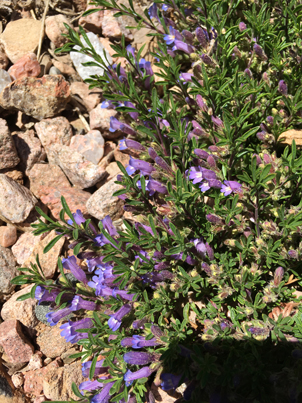
Mat Penstemon - Penstemon caespitosus
Description
"Penstemon caespitosus is native to Wyoming, Colorado and Utah. It is a mat-forming perennial that typically forms low tufts to 2” tall and spreads by slender, prostrate, creeping stems. Stems are clad with tiny, narrow, linear to spatulate leaves (to 1/2” long). Lavender-purple, two-lipped flowers (to 1/4” long) with hairy throats bloom in summer.
Genus name comes from the Greek words penta meaning five and stemon meaning stamen in reference to each flower having five stamens (four are fertile and one is sterile).
Specific epithet means growing in tufts, in reference to the plant habit.
Penstemons are sometimes commonly called beardtongues because the sterile stamen has a tuft of small hairs." (missouribotanicalgarden.org)
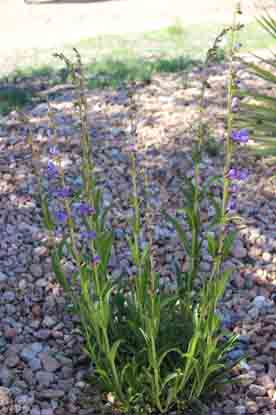 |
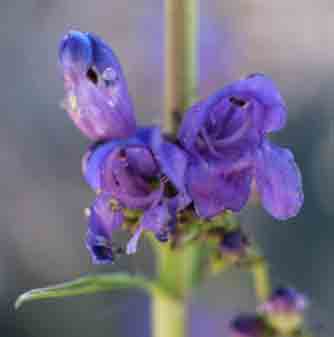 |
Plant w/Flowers |
Flowers |
Rocky Mountain Penstemon - Penstemon strictus
Description
"This species is a herbaceous perennial with a few stems rising nearly straight up from a thick crown. The leaves are long and narrow, with stem leaves smaller and especially narrower than the basal leaves. The leaves are entire and smooth, or possibly downy near the petiole. The inflorescence is a spike (technically a thyrse of 4 to 10 verticillasters). The corolla is 24 to 32 mm (1 to 1.5 inches) long, deep blue with a violet tube, and smooth.[1] The two upper petals point straight along the tube, like a porch roof (hence the seldom-used name "porch penstemon").[2] The seed capsules are 8 to 13 mm long.[1]" (wikipedia.com)
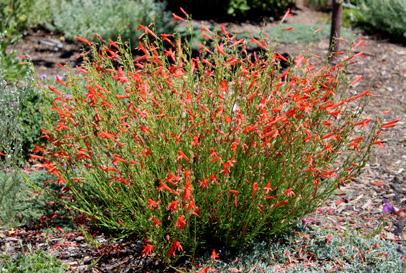 |
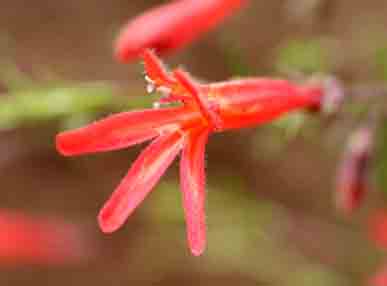 |
Plant w/Flowers |
Flower |
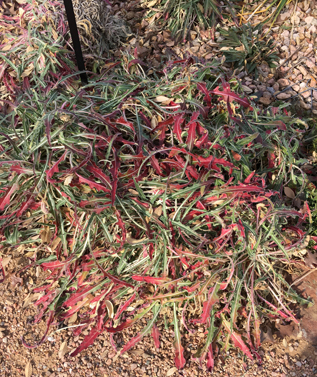 |
Winter |
Bridges Penstemon - Penstemon rostriflorus 'Bridges'
Description
"First time summer visitors to the Rockies are often struck by the abundance of scarlet tubular flowers everywhere you look in the high meadows. One often sees hummingbirds darting from scarlet gilia to penstemons in the summer months, always a highlight for the observant visitor. Many of these mountain plants adapt well to the Xeriscape or border in your home garden. Three scarlet penstemons span the summer season: the sharkshead penstemon (Penstemon barbatus) often starts blooming in late May, and tubular Eaton’s penstemon (Penstemon eatonii) carries the show into July. But the longest bloomer, and longest lived of the scarlet penstemons may only start to bloom later that month. Bridges’ penstemon flowers throughout much of the American southwest from Colorado to California. It forms an attractive, somewhat shrubby mound of narrow green foliage with stems 2-3″ in height with a succession of brilliant orange-red flowers from late July all the way to October most years." (plantselect.org)
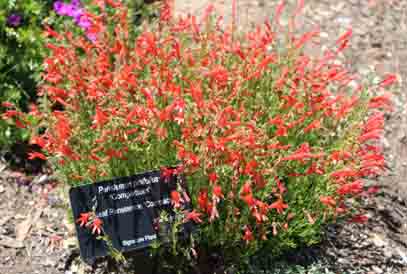 |
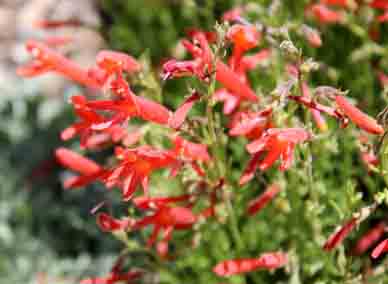 |
Plant w/Flowers |
Flowers |
Compact Pineleaf Penstemon - Pestemon pinifolius 'Compactum'
Description
"A species of Beard-tongue native to the Southwestern USA, this grows well in most regions except for the humid South. It forms a low, bushy mound with green leaves that resemble pine needles. Tubular flame-orange flowers appear in early to midsummer, and are a magnet for hummingbirds. Because this plant is woody at the base, prune no lower than 4 inches in spring. Gorgeous in a rock garden or dry border, and looks particularly good with a mulch of gravel beneath. Evergreen in mild winter regions. Very drought tolerant once established. Well worth trying in Zones 3 or below." (perennials.com)
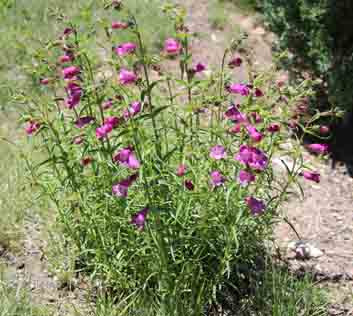 |
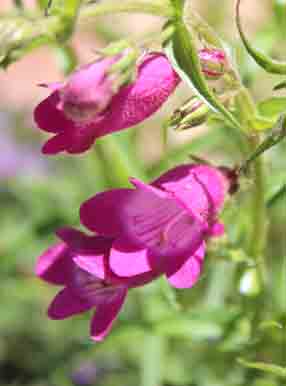 |
Plant w/Flowers |
Flowers |
Red Rocks Penstemon - Penstemon baratus x meicali 'Red Rocks'
Description
"Tall, showy spikes of bright rose-red flowers rise above mounded dark green foliage throughout summer. This adaptable native hybrid thrives in a wide range of soils and conditions. Makes a colorful impact in sunny borders, meadows and naturalized gardens. A Plant Select® winner. An herbaceous perennial." (monrovia.com)
 |
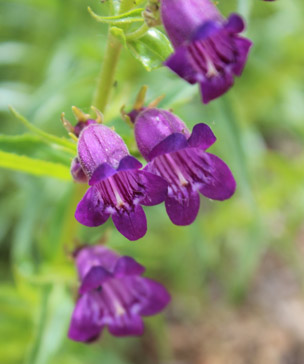 |
Plant w/Flowers |
Flowers |
Pike's Peak Penstemon (Purple Beardtongue) - Penstemon barbatus x mexicali 'Pike's Peak Purple'
Description
"Tall, vibrant spikes of grape-colored, nectar-rich flowers throughout summer. This versatile Plant Select® winner is adaptable to a wide range of soils and conditions. The slightly cascading growth habit makes it perfect for use in sunny borders, meadows and naturalized landscapes. An herbaceous perennial." (monrovia.com)
 |
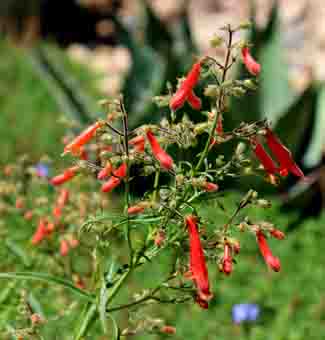 |
Plant w/Flowers |
Flowers |

Leaves
Scarlet Bugler Penstemon - Penstemon barbatus
Description
"Penstemon barbatus is very common throughout the lower elevations of the Four Corners area, and it is abundant in Mesa Verde National Park. This is a very tall and lanky Penstemon, often growing to four or five feet with an abundance of flowers opening over many weeks. Stem leaves are long, narrow, and widely spaced.
For a very similar species that is also abundant in the Four Corners, see Penstemon rostriflorus. Although the flowers of the two species are somewhat similar, the forms are quite different: P. barbatus is tall, lanky, and airy whereas P. rostriflorus is much shorter and crowded. Also, P. barbatus blooms in June and July and is flexible and herbaceous throughout. P. rostriflorus blooms from late June into October and is quite woody at its base. And most unusual for any of our local Penstemons, P. rostriflorus is commonly evergreen.
Penstemon barbatus was named by Albrecht Roth in 1846 from a collection made in Mexico.
"Barbatus" is Latin for "hairy" or "bearded" and refers to the hairy flower throat of variety barbatus." (swcoloradowildflowers.com)
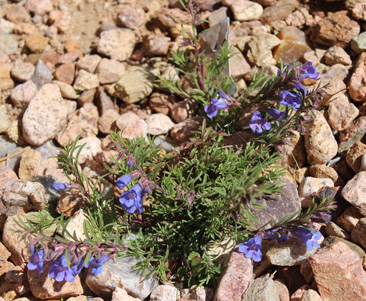 |
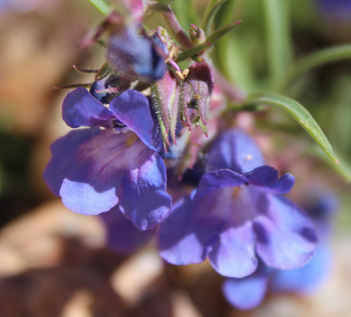 |
Plant w/Flowers |
Flowers |
Penstemon linariodies
Description
"Duration: Perennial Nativity: Native Lifeform: Subshrub General: Stems erect or ascending to 50 cm tall, puberulous or glabrate. Leaves: Opposite, linear, mucronate, about 2 mm wide, those at the base of the stem and on short sterile shoots crowded, the cauline ones scattered. Flowers: Inflorescence narrow, secund, glandular; floral bracts small, subulate, calyx 4-7 mm long, lobes ovate, scarious margined; corolla purple to violet, 15-20 mm long, with deep purple guidelines, tube slender, throat 2-ridged and abruptly expanded on upper side, strongly bearded with yellowish hairs at the base of the lower lobes; staminode bearing bright yellow hairs along most of the length and in a tuft at the tip. Fruits: Septicidal capsule. Ecology: Found on dry slopes and flats from 4,500-7,500 ft (1372-2286 m); flowers June-August. Notes: This species can be distinguished by its secund inflorescence, the narrow linear opposite leaves which are crowded at the base and less so as you move up the stem, and the distinctive yellow beard in the violet flower. There are several other subspecies in the region, particularly important is subsp. coloradoensis Ethnobotany: Unknown Etymology: Penstemon is from Greek pente, five and stemon, indicating the five stamens of the genus, while linarioides means like the genus Linaria. Synonyms: None Editor: SBuckley, 2010" (SEINet)
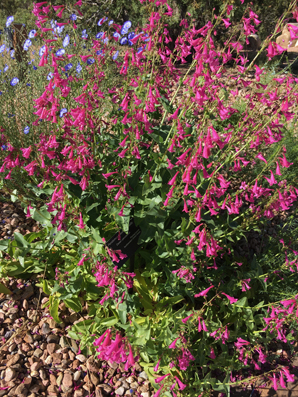
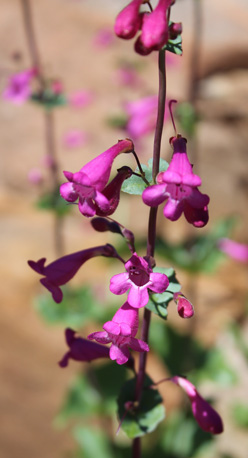 |
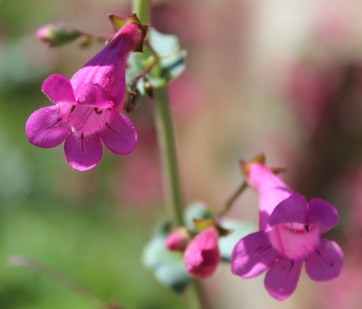 |
Desert (Beardtongue) Penstemon - Penstemon pseudospectabilis
(Rosy Desert Beardtongue, Pink Showy Penstemon and Arizona Penstemon)
(behind the orchard bench, on art trail and in front of the pavillion)
Description
"Penstemon pseudospectabilis is a species in the Plantaginaceae (Plantain) family known by the common name Desert Beardtongue or Desert Penstemon. It is native to the southwestern United States, where it grows in desert and plateau habitat types, such as sandy washes, scrub, and woodland. In California it is found primarily in the Mojave Desert. The plant is generally a shrub growing to a maximum height of one meter, with many erect stems. The thin leaves are roughly oval with wide pointed tips and serrated edges. They are arranged oppositely in pairs and many pairs are completely fused at the bases about the stem, forming a disc. The flower cluster bears tubular flowers with expanded, lobed mouths and hairy hairs on most surfaces, except the hairless staminode. The flower may be up to 2.5 centimeters long and is reddish pink in color.
Like most Penstemons, this species is very showy when in flower. Though native to hot, arid locations it is adaptable to most of southern California and is tolerant of garden conditions. give it plenty of sun and fast drainage, When in bloom it will be constantly in use by bees, butterflies and hummingbirds." (calscape.org)
"Penstemon pseudospectabilis (desert beardtongue, or desert penstemon) a species of penstemon. It is native to the southwestern United States, where it grows in desert and plateau habitat types, such as sandy washes, scrub, and woodland. The plant is generally a shrub growing to one meter, with many erect stems. The thin leaves are oval with wide, pointed tips and serrated edges. They are arranged oppositely in pairs, many are completely fused at the bases about the stem, forming a disc. The inflorescence bears tubular flowers with expanded, lobed mouths and glandular hairs on most surfaces, except the hairless staminode. The flower grows to 2.5 centimeters and is reddish pink." (Wikipedia)

Penstemon linariodes x coloradoensis 'Silverton'
(at the entrance to the orchard; coming from xeric garden on the right, and after turning to the right, there is another one with lots of flowers in the perennial bed)
Description
"This tiny Penstemon typically grows in one foot diameter circular patches, primarily in the dry soils of the Pinyon-Juniper and Ponderosa communities, but it will grow to several feet in diameter and ten inches tall if it receives good moisture -- as it did in 2005.
Flowers are about a half inch long, often profuse, and always a very lovely pale lavender. It is common to see hundreds of these plants in bloom along the Prater Ridge Trail of Mesa Verde National Park and they are quite common in similar habitats in the Four Corners area.
Compare Penstemon linarioides with Penstemon crandallii.
William Weber indicates that the species name refers to the similarity of the leaves of Linarioides to the leaves of Linaria which in turn has its name because of similarities with Linum (Flax). And all of this is from the Latin "lin", a "line", i.e., they all have somewhat similar linear leaves.
The plant was first collected for science by Charles Wright in New Mexico in 1851-1852 and was named by Asa Gray in 1858." (swcoloradowildflowers.com)
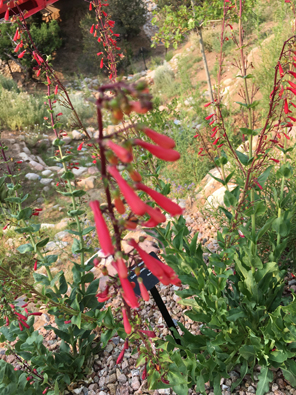 |
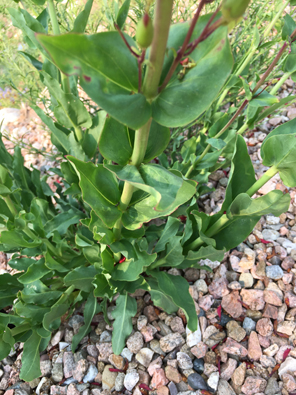 |
Cardinal Penstemon - Penstemon cardinalis
(on left side of bridge in Ojo y Manos)
Description
"Perennial herb; stems 40-100 cm tall; leaves opposite, thick, to 6 cm long and 5 cm wide, heart-shaped; inflorescence secund (one-sided), the cymules paired, well spaced, 2-flowered; calyx 4-6 mm long; corolla 26-30 mm long, red, narrowed at the mouth, lobes small, the lower bearded with soft, yellow hairs. Flowers May to June." (nmrareplants.unm.edu)
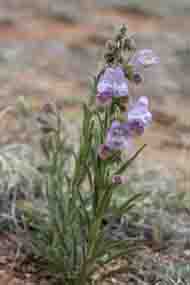 |
 |
James' Penstemon - Penstemon jamesii
(in front of pavilion before bridge)
Description
"Duration: Perennial Nativity: Native Lifeform: Forb/Herb General: Perennial herb, 10-50 cm tall, from a woody caudex; stems 1-7 per plant, ascending to erect, glabrate or retrorsely puberulent near the base and glandular-pubescent near the top. Leaves: Opposite along the stems and also in a basal cluster; lower leaves petiolate and upper leaves sessile to clasping; blades oblanceolate to linear, 2-10 cm long and 5-15 mm wide, the margins entire to serrate and sometimes retrorsely puberulent. Flowers: Purplish and showy, arranged in secund (one-sided) panicles, 5-20 cm long, at the tops of the stems; sepals 5 per flower; ovate to lanceolate, 8-12 mm long; corolla 24-35 mm long, ventricose (asymmetrically inflated), constricted at the throat, and 2-lipped, with the 2 upper lobes projecting (sticking straight out, not curvng upward or downward), and the 3 lower lobes spreading to reflexed (outward- to downward-pointing); outer surface of the corolla white to lavender, pink, or violet and glandular-pubescent; inside surface of corolla white-pilose and glandular pubescent, with magenta or blue-violet nectar guide lines. Staminode (single sterile stamen) prominently exserted (sitcking out) from flower, with a recurved tip, the entire staminode covered with yellow hairs. Fruits: Capsules 10-16 mm long, glabrous; splitting open longitudinally to release black, angled seeds, 2-3 mm long. Ecology: Found in sandy, gravelly, or loamy soil in shortgrass prairies and sagebrush shrublands, from 3,500-7,500 ft (1067-2286 m); flowers May-July. Distribution: CO, KS, NM, TX, south to MEX Notes: This purple Penstemon is most similar to P. ophianthus but that species has a smaller flower, 14-22 mm long (P. jamesii has a corolla 24-35 mm long). While both species have asymmetrically inflated corollas, in P. jamesii the corolla is abrubtly constricted at the top of the throat, making the inflated portion of the corolla look more bladdery compared to P. ophianthus. Both species are characterized by the single sterile stamen (staminode) prominently sticking out of the flower, curling at the tip, and being covered by yellow hairs. In contrast, P. virgatus has a shorter, flat, non-hairy staminode. P. fendleri, another purple Penstemon, differs because it does not have an inflated corolla. Ethnobotany: Used as an analgesic, emetic, and throat aid." (SEINet)
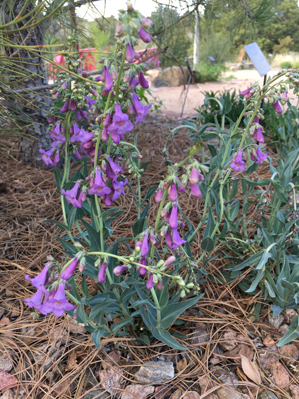 |
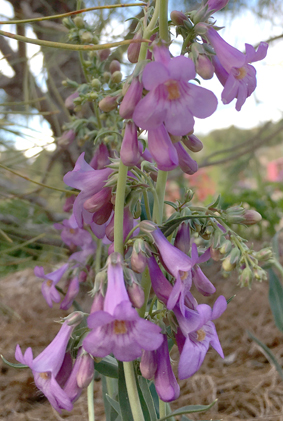 |
The plant w/flowers |
The flowers |
Sidebells Penstemon - Penstemon secundiflorus
(Sidebells Beardtongue, One-sided Penstemon )
(on main trail at intersection with the Art Trail)
Description
"Beard-tongues are native North American wildflowers, available in a surprising range of colours, heights and textures. This hybrid selection was developed in Nebraska, chosen for its hardiness and ease of growth. Plants form a low clump of green foliage, with upright spikes appearing in early summer. Flowers are vivid purple trumpets, attractive in the border and useful for cutting. Combines well with the pink form ‘Elfin Pink'. Both are excellent low-maintenance perennials, especially for hot, dry sites. Attractive to both butterflies and hummingbirds." (Perennials.com)
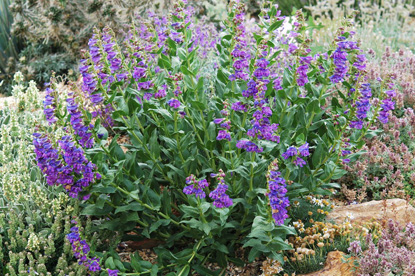
Alpine Sawsepal Penstemon - Penstemon alpinus
(over on the far east side of the art trail in front of a large juniper and pinyon)
Description
"Stems 10-80cm tall. Leaves entire, glabrous to puberulent, often rather thick, exceedingly variable in size. Mostly lanceolate. Flowers secund, inflorescence congested. Flowers blue or bluish-purple, 22-32mm Southeastern Wyoming to northern New Mexico. Gravelly soils from the base of the mountains to 3800m. subsp. brandegei has robust stems, 30-70cm tall, flowers 30-3 8mm long. Spectacular blue flowers, showy." (Alpine Garden Society)
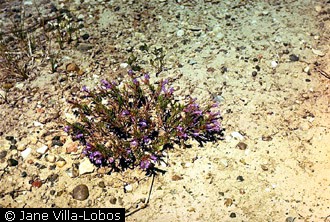
'Firleaf Beardtongue' - Penstemon abietinus
(along the slope of the walkway to the xeric garden, on left as you are walking from orchard)
Description
"Penstemon grinnellii is a species of penstemon known by the common name Grinnell's beardtongue. It is endemic to California, where it can be found in several mountain ranges from those around the San Francisco Bay Area to the Sierra Nevada to the Peninsular Ranges near the Mexican border. It is a perennial herb producing upright stems growing to 85 centimeters in maximum height. The leaves are oblong, up to 9 centimeters in length, folded lengthwise and curved backward. The hairy flower cluster produces several tubular purple-tinged white or violet flowers 1 to 2 centimeters long. The mouth of the flower has three lower lobes streaked with dark lines, a hairy throat and a long-haired, protruding staminode." (California Native Plant Society)
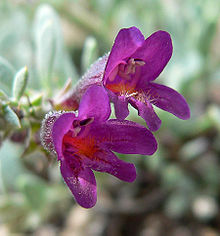 |
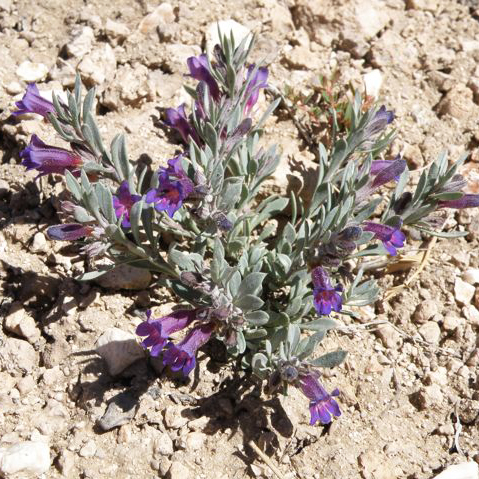 |
Penstemon thomposniae spp. jaegeri
(near Penstemon abietinus, in corner close to orchard)
Description
"Penstemon thompsoniae is a species of penstemon known by the common name Thompson's beardtongue. It is native to the southwestern United States where it grows in woodlands and other desert and plateau habitat, to the subalpine climate of local mountains. It is a mat-forming perennial herb, ashy gray-green with a thick coating of hairs, growing no more than 15 centimeters tall from a woody base. The oval or spoon-shaped leaves are up to 2 centimeters long. The short inflorescence bears wide-mouthed tubular purple flowers up to 2 centimeters in length. They are glandular on the outer surface and somewhat hairy on the inner, the staminode coated in long orange hairs.
Of the two subspecies of this plant, only ssp. thompsoniae occurs throughout the species' range. Jaeger's beardtongue, ssp. jaegeri, is endemic to southern Nevada.[1]" (Wikipedia)
 |
 |
The plant w/flowers |
The flowers |
Firecracker Penstemon - Penstemon eatonii
Description
"Penstemon eatonii is a species of penstemon known by the common name firecracker penstemon.
It is native to the Western United States, from Southern California to the Rocky Mountains. It grows in many types of desert, woodland, forest, and open plateau habitat." (Wikipedia)
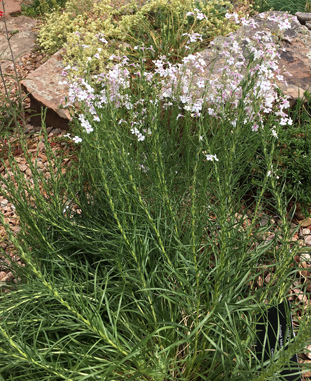 |
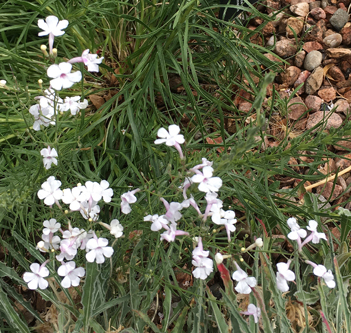 |
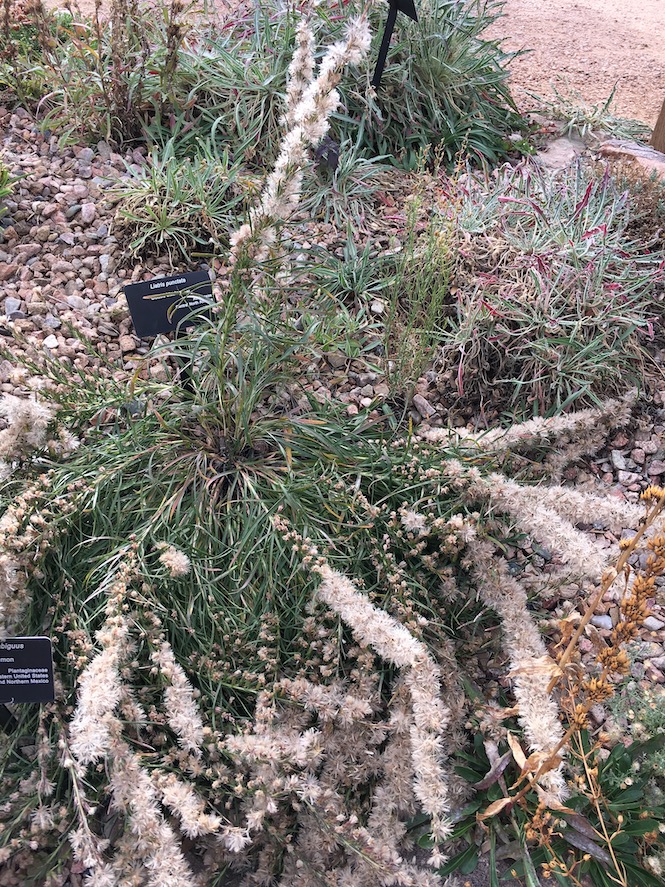 |
Plant w/flowers (wikipedia) |
Flowers |
Plant w/seeds |
Sand Penstemon (Sand Dune Penstemon, Sharpleaf Penstemon, Sharp-leaved Penstemon) - Penstemon acuminatus
Description
"Penstemon acuminatus is a species of flowering plant in the plantain family known by the common names sharpleaf penstemon and sand-dune penstemon. It is native to the northwestern United States, where it occurs in Washington, Oregon, Idaho, Utah, and Nevada.[1]
This species is a perennial herb growing up to 60 centimeters tall with one or more erect stems. The basal leaves are up to 10[1]to 15 centimeters long[2] and those higher on the stem are up to 7. They may clasp the stem at their bases. The fleshy leaves and the stem may be waxy in texture. The tubular blue, purple, or pink flowers are up to 2 centimeters long. They have wide throats and flaring corollas. The staminode has a beard of yellow hairs.[1][2]
This plant grows in sandy habitat types,[2] such as dunes.[1]
This species is used for revegetation of wildlife habitat, for landscaping and gardens, and for seeding roadsides.[1]" (Wikipedia)
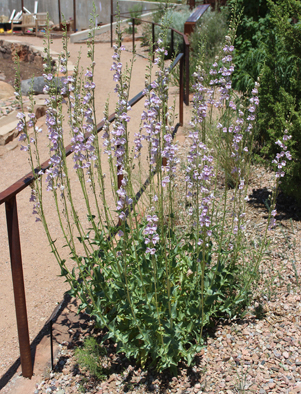 |
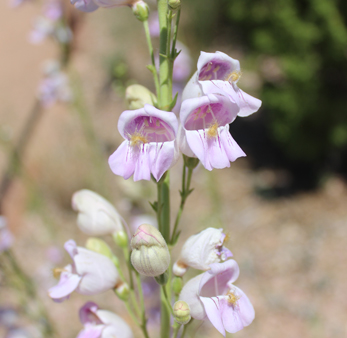 |
The plant w/flowers |
The flowers |
Palmer's Penstemon - Penstemon palmeri
Description
"Penstemon palmeri, Palmer's penstemon, grows erect and may reach 2 metres (6.6 ft) in maximum height. The leaves are generally oppositely arranged and have toothed margins. The inflorescence is a panicle or raceme with small bracts.[1][3]
The flower has a five-lobed calyx of sepals and a cylindrical corolla with may have an expanded throat. The staminode is partially hairy. The showy, rounded flower has large pink to violet to blue-purple petals. Occasional specimens are red, yellow, or white flowered.[3]" (Wikipedia)
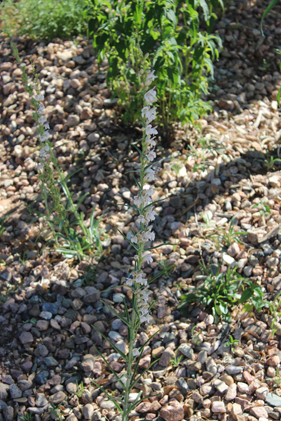 |
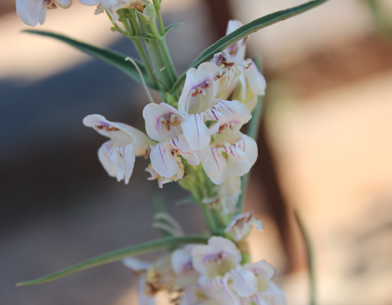 |
The plant w/flowers |
The flowers |
Penstemon virgatus - white variety
Description
"Duration: Perennial Nativity: Native Lifeform: Forb/Herb General: Perennial herb, 20-65 cm tall, from a woody caudex; stems 1-7 per plant, straight and erect, puberulent to glabrous. Leaves: Opposite along the stems, occasionally with a basal cluster of leaves as well; lower leaves have petioles and upper leaves are sessile; blades oblanceolate to lanceolate, 2-12 cm long and 3-20 mm wide, glabrous to puberulent, with entire margins. Flowers: Showy and purplish; arranged in narrow one-sided (secund) panicles, 6-40 cm long; sepals 5 per flower, ovate to elliptic, 2-5 mm long, glabrous or hairy; corolla 17-27 mm long, asymmetrically inflated (ventricose), slightly constricted at the top of the throat, and 2-lipped, the upper 2 lobes arched or projecting (not curved in or out), and the lower 3 lobes spreading to reflexed (curved outward to downward); outside surface of corolla glabrous, violet to lavender, pink-lavender or purple; inside of corolla sparsely white-hairy on one side, with red-purple nectar guide lines. Steminode (single sterile stamen) slightly exserted from flower, straight, and glabrous. Fruits: Capsules 9-14 mm long; splitting open longitudinally to release dark brown angled seeds, 2 mm long. Ecology: Found in sandy to gravelly soils in oak woodlands, pine forests, and roadsides, from 5,000-10,000 ft (1524-3048 m); flowers June-October. Distribution: AZ, NM, CO, WY Notes: Another purple Penstemon. Similar to P. ophianthus and P. jamesii, but those species have glandular-pubescent corollas (inside and outside) and the sterile stamen inside each flower (staminode) is hairy, curled, and sticks out of the flower. In contrast, the corolla on P. virgatus is glabrous on the outside and sparsely hairy on the inside surface, and each flower has a straight, non-hairy staminode that just reaches the opening of the corolla or else sticks out a little. Distinguish from P. fendleri based on corolla shape; that species does not have an inflated corolla. Ethnobotany: Used ceremonially by the Ramah Navajo. Etymology: Penstemon comes from the Latin paene, nearly or almost, and Greek stemon, thread, alluding to the single sterile stamen within each flower; virgatus means wand-like, or straight, slender and erect." (SEINet)
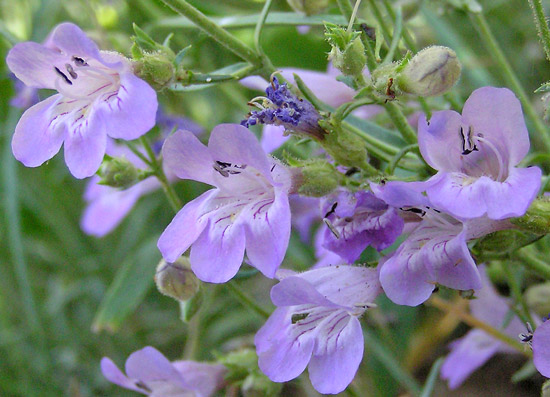
Penstemon, Toadflax - Penstemon linarioides subsp.coloradoensis
Description
This tiny Penstemon typically grows in one foot diameter circular patches, primarily in the dry soils of the Pinyon-Juniper and Ponderosa communities, but it will grow to several feet in diameter and ten inches tall if it receives good moisture -- as it did in 2005, 2017, and the winter of 2018-2019. But as the photograph immediately above indicates, once the attractive leaves and flowers have faded and the plant has gone to seed, it is difficult to see -- even when blown up in a photograph.
Flowers are about a half inch long, often profuse, and always a very lovely pale lavender. It is common to see hundreds of these plants in bloom along the Prater Ridge Trail of Mesa Verde National Park and they are quite common in similar habitats in the Four Corners area. - SW Colorado Wildflowers
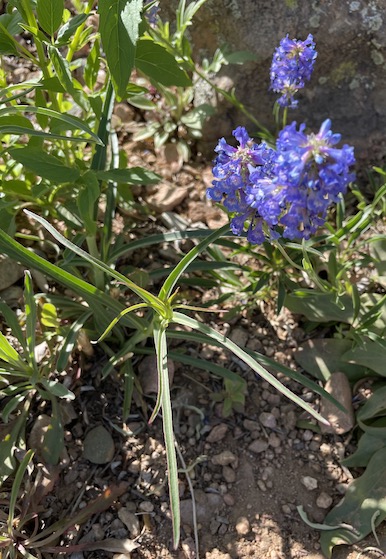 |
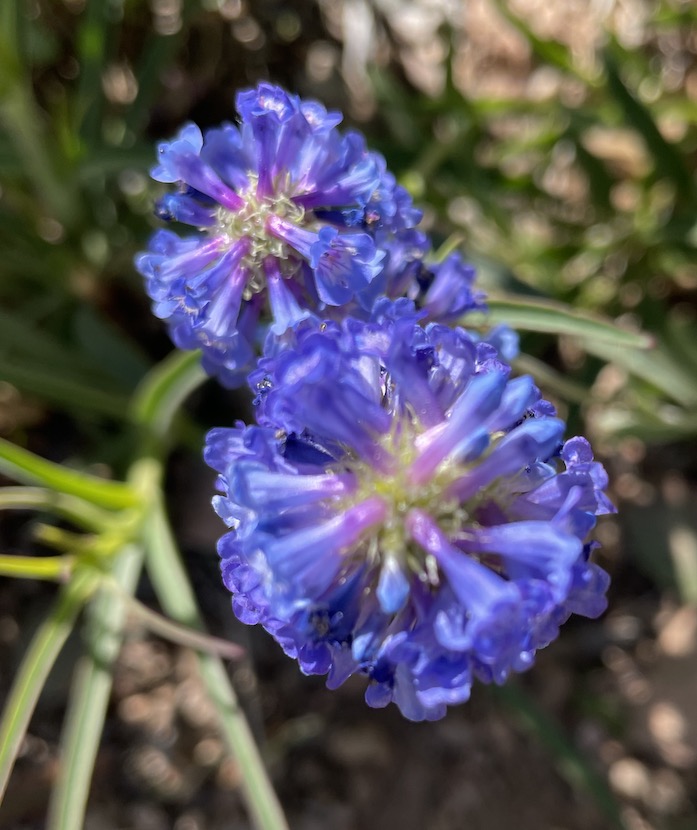 |
| Plant w/flowers | Flowers |
Penstemon, (Wasatch beardtongue) - Penstemon cyananthus
Description
An erect plant with several leafy stems, and blue-violet bilaterally symmetrical flowers in rings near the top. Erect, smooth, 1-2 ft. stems with pairs of clasping, lance-shaped, 1-4 in. leaves are topped by densely clustered rings of bright blue to blue-violet flowers. Each of the inch-long, smooth, tubular flowers has a 2- lobed upper lip and a 3-lobed lower lip.
This is a common spring wildflower in its area, often filling disturbed ground with handsome patches of blue. An alternate common name for the genus is beardtongue, referring to the bearded sterile stamen, as in this species. (wildflower.org)